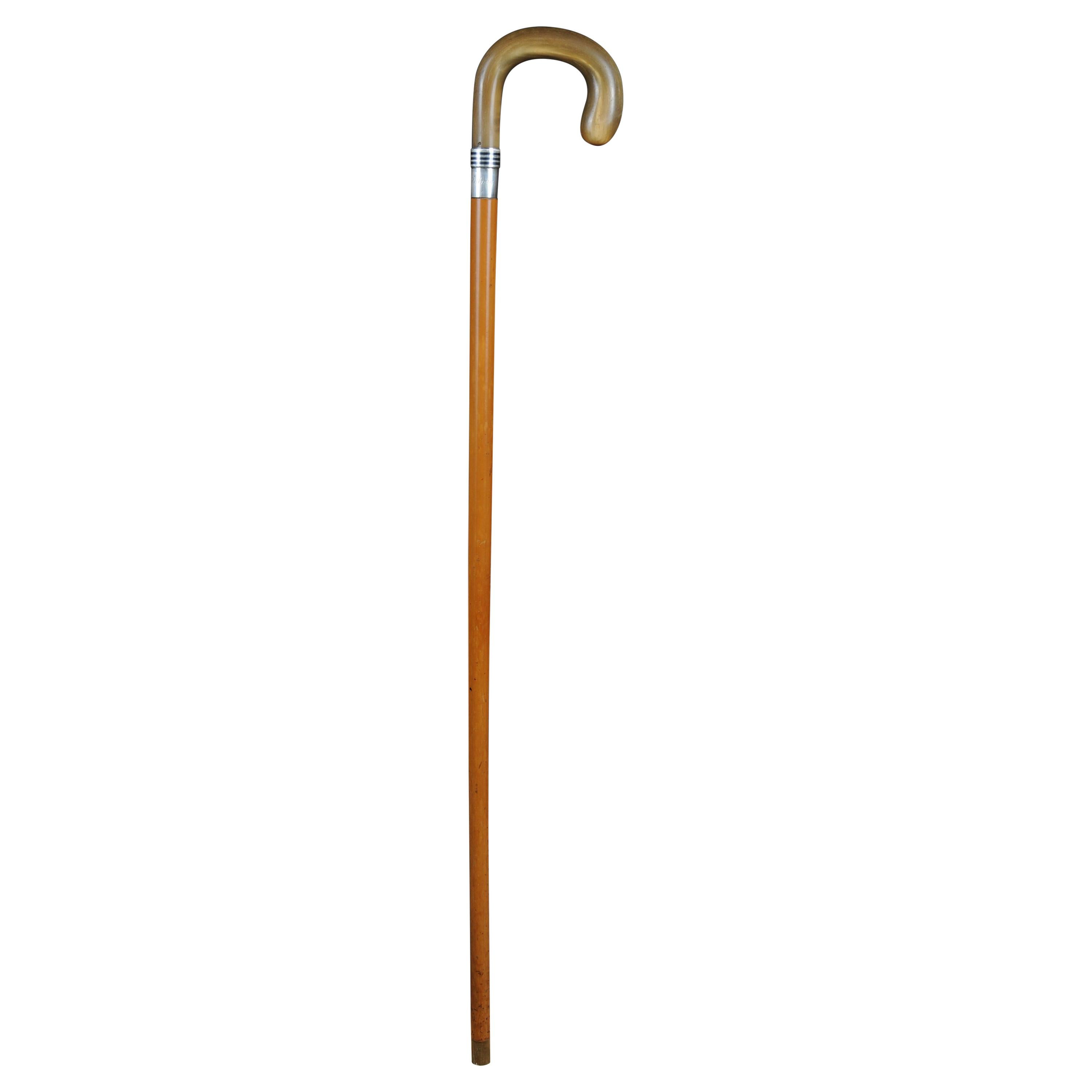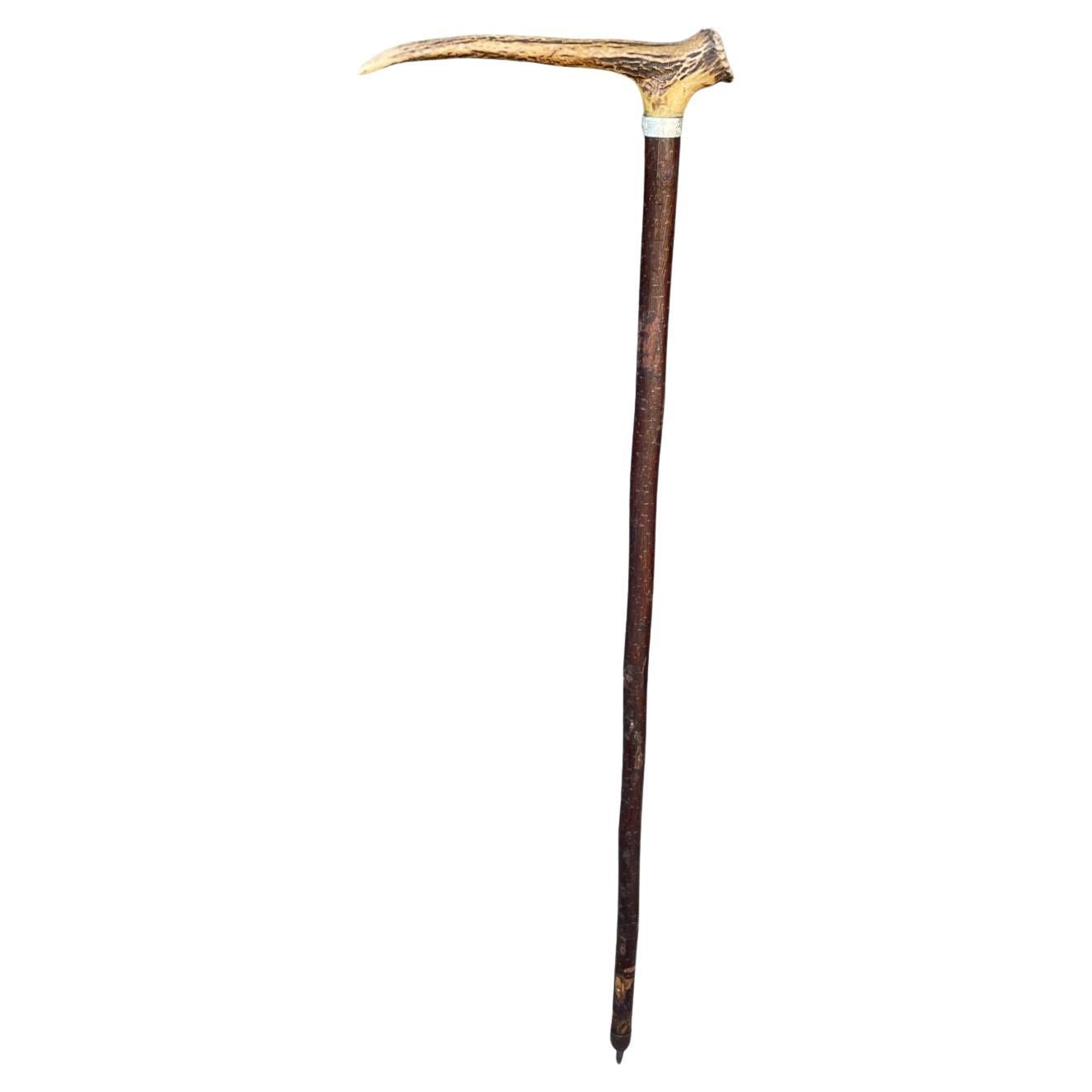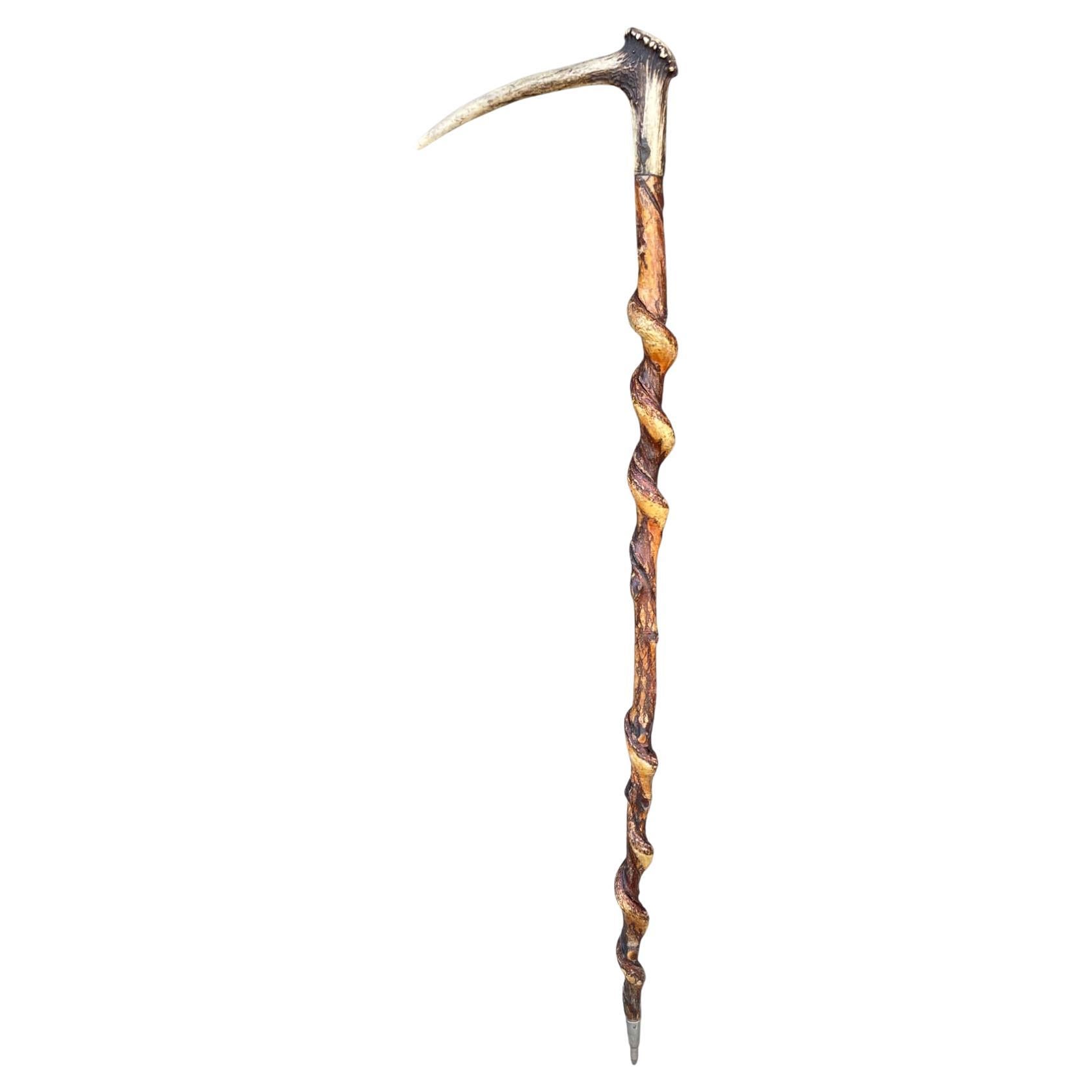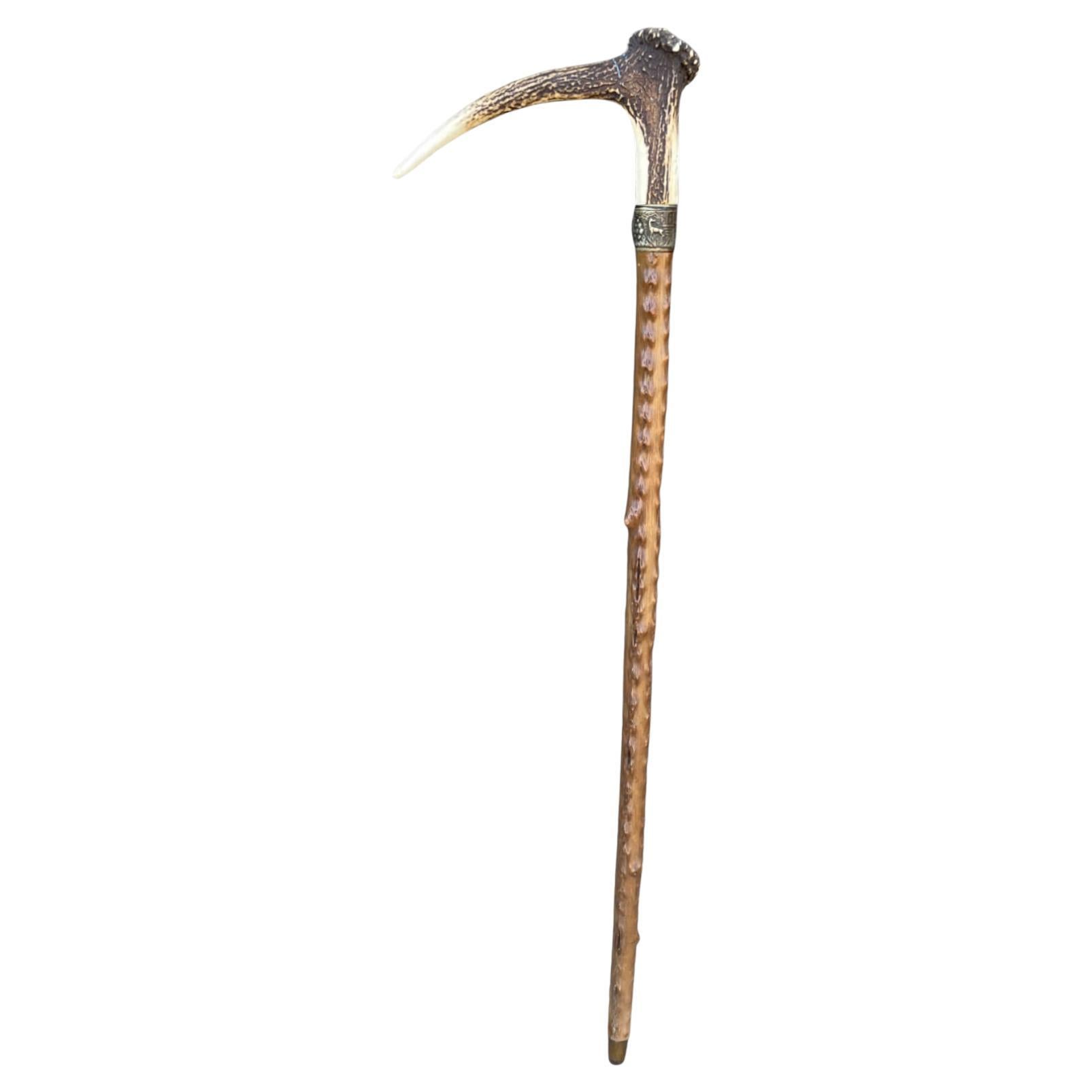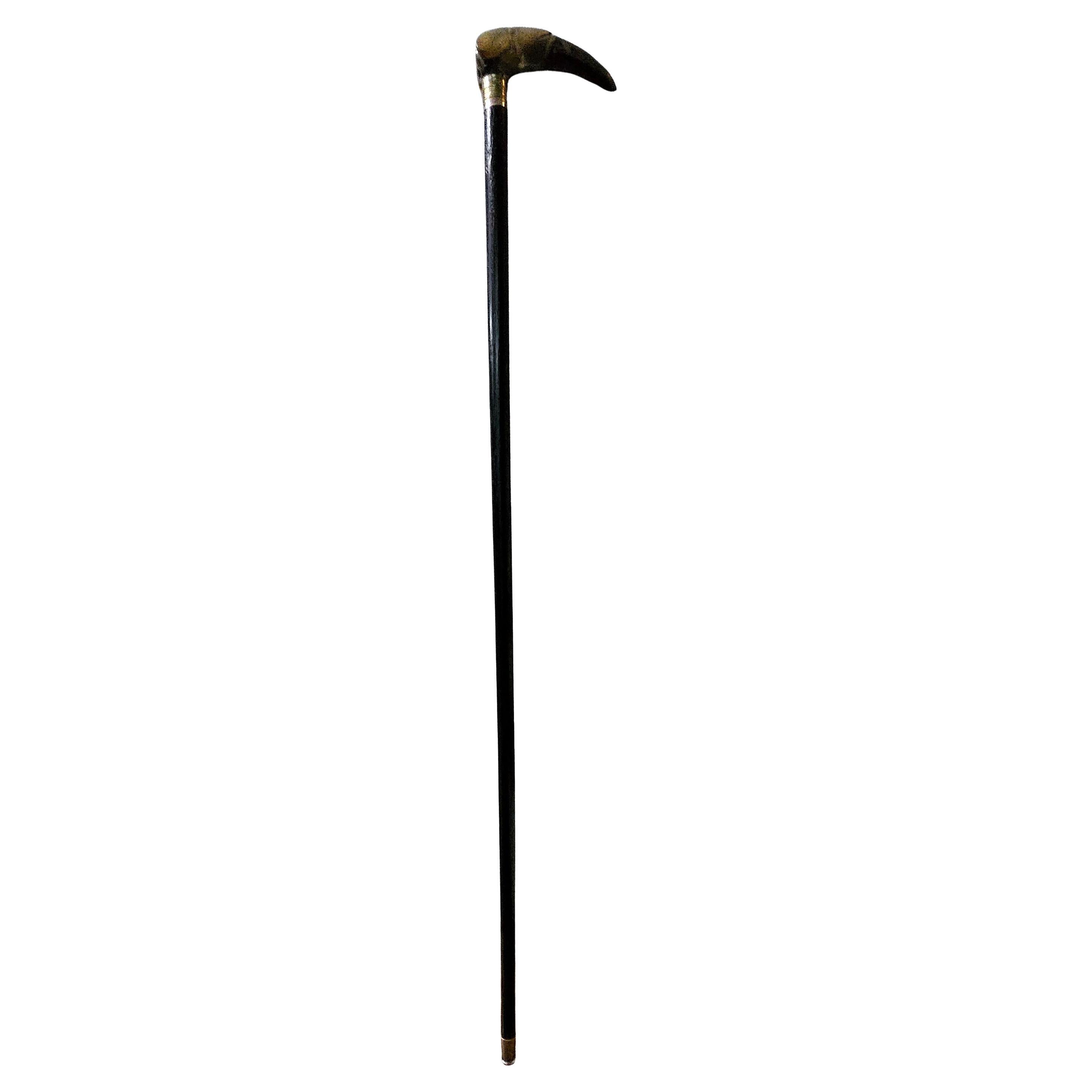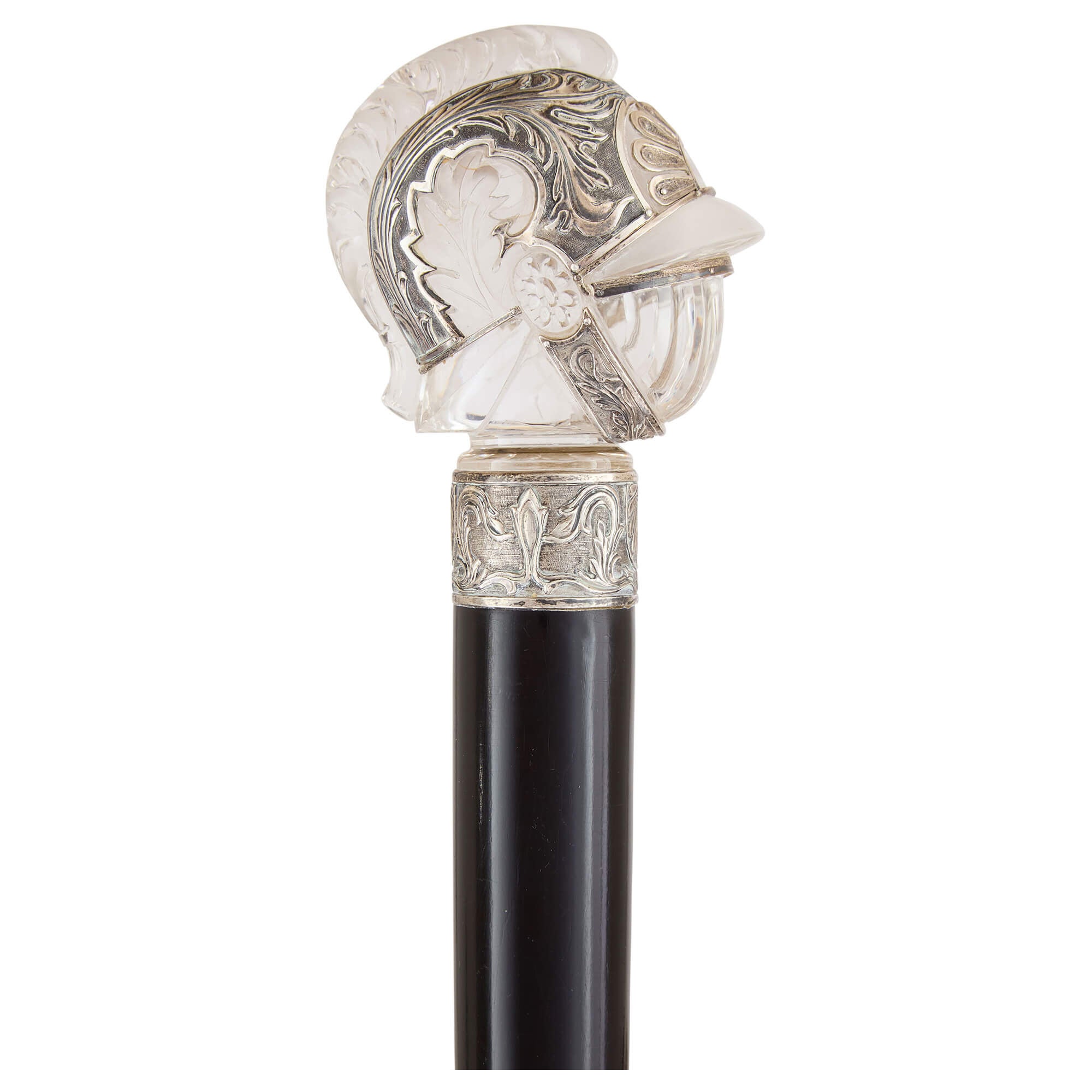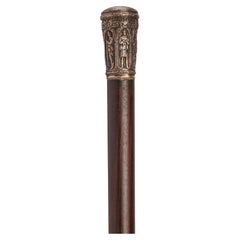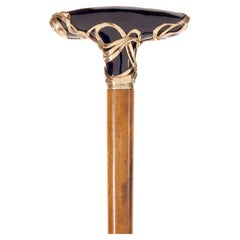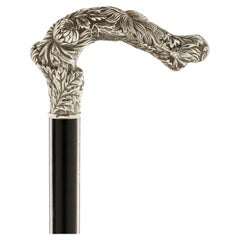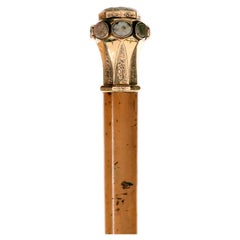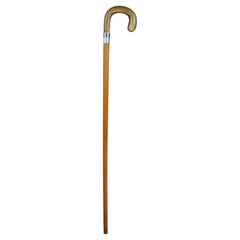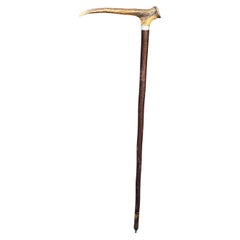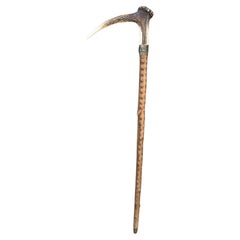Items Similar to Walking stick made by W. A. Bolin, horn and silver gilt. Stockolm, Sweeden 1917.
Video Loading
Want more images or videos?
Request additional images or videos from the seller
1 of 19
Walking stick made by W. A. Bolin, horn and silver gilt. Stockolm, Sweeden 1917.
$8,087.31
£6,017.79
€6,800
CA$11,111.52
A$12,401.41
CHF 6,524.56
MX$150,642.92
NOK 82,714.03
SEK 77,409.97
DKK 51,765.80
About the Item
Walking stick with a cane made of Malacca wood and a pommel of ox horn with bands and a gilded silver cap depicting a double-headed eagle.The pommel is made of black ox horn enriched with a silver decoration. The band is smooth, surmounted by a ring with circular decorations that continues in a series of bands with curved sides at the base and along the back of the horn, following its natural shape. At the top is a large curved openwork, closed below by a smooth plaque. The coat of arms depicted is Russian, with the crowned double-headed imperial eagle at the center, with outstretched wings, the imperial insignia of the orb, and the scepter. At the center is the Moscow coat of arms of Saint George. Surrounding it is a wreath of single laurel leaves with a ribbon at the base. The date 1917 is carved into a gilded silver plate on the right, and the initials 'I P I' in Cyrillic on the left. Signed W. A. Bolin. The venerable Bolin firm was founded in St. Petersburg in 1796 by the German Andreas Roempler. In the 1830s, his youngest daughter married Carl Edvard Bolin, a Swedish émigré. In 1834, the firm changed its name to Jahn & Bolin. Bolin and his brother Henrik Conrad later took over the firm, changing the name to Bolin. In 1839, the firm was appointed jeweler to the Swedish Imperial Court. A branch was opened in Moscow, and for many years, the firm prospered under the leadership of Wilhelm James Andreevitch Bolin (1861–1934), so much so that by the end of the century it was in direct competition with the renowned firm of Peter Carl Fabergé. Fortunately, many of the Bolins retained Swedish citizenship and purchased property in that country. By the time the Bolsheviks finally confiscated the Bolins' Russian business, the family had already opened a branch in the German spa town of Bad Homburg. In 1916, the business moved to Stockholm.Walking stick with a cane made of Malacca wood and a pommel of ox horn with bands and a gilded silver cap depicting a double-headed eagle.The pommel is made of black ox horn enriched with a silver decoration. The band is smooth, surmounted by a ring with circular decorations that continues in a series of bands with curved sides at the base and along the back of the horn, following its natural shape. At the top is a large curved openwork, closed below by a smooth plaque. The coat of arms depicted is Russian, with the crowned double-headed imperial eagle at the center, with outstretched wings, the imperial insignia of the orb, and the scepter. At the center is the Moscow coat of arms of Saint George. Surrounding it is a wreath of single laurel leaves with a ribbon at the base. The date 1917 is carved into a gilded silver plate on the right, and the initials 'I P I' in Cyrillic on the left. Signed W. A. Bolin. The venerable Bolin firm was founded in St. Petersburg in 1796 by the German Andreas Roempler. In the 1830s, his youngest daughter married Carl Edvard Bolin, a Swedish émigré. In 1834, the firm changed its name to Jahn & Bolin. Bolin and his brother Henrik Conrad later took over the firm, changing the name to Bolin. In 1839, the firm was appointed jeweler to the Swedish Imperial Court. A branch was opened in Moscow, and for many years, the firm prospered under the leadership of Wilhelm James Andreevitch Bolin (1861–1934), so much so that by the end of the century it was in direct competition with the renowned firm of Peter Carl Fabergé. Fortunately, many of the Bolins retained Swedish citizenship and purchased property in that country. By the time the Bolsheviks finally confiscated the Bolins' Russian business, the family had already opened a branch in the German spa town of Bad Homburg. In 1916, the business moved to Stockholm.
- Creator:William Bolin (Jeweler)
- Dimensions:Height: 37.5 in (95.25 cm)Width: 3.5 in (8.89 cm)Depth: 1.75 in (4.45 cm)
- Materials and Techniques:
- Place of Origin:
- Period:
- Date of Manufacture:1917
- Condition:Wear consistent with age and use.
- Seller Location:Milan, IT
- Reference Number:1stDibs: LU917146185352
About the Seller
5.0
Vetted Professional Seller
Every seller passes strict standards for authenticity and reliability
Established in 1991
1stDibs seller since 2011
247 sales on 1stDibs
Typical response time: 1 hour
- ShippingRetrieving quote...Shipping from: Milan, Italy
- Return Policy
Authenticity Guarantee
In the unlikely event there’s an issue with an item’s authenticity, contact us within 1 year for a full refund. DetailsMoney-Back Guarantee
If your item is not as described, is damaged in transit, or does not arrive, contact us within 7 days for a full refund. Details24-Hour Cancellation
You have a 24-hour grace period in which to reconsider your purchase, with no questions asked.Vetted Professional Sellers
Our world-class sellers must adhere to strict standards for service and quality, maintaining the integrity of our listings.Price-Match Guarantee
If you find that a seller listed the same item for a lower price elsewhere, we’ll match it.Trusted Global Delivery
Our best-in-class carrier network provides specialized shipping options worldwide, including custom delivery.More From This Seller
View AllSilver Handle Walking Stick, France, 1915.
Located in Milan, IT
Walking stick: silver knob milord shape handle, depicting six soldiers, representing six European states involved in the First World War conflict. Ebony m...
Category
Early 20th Century French Figurative Sculptures
Materials
Metal, Silver
Jewel walking stick in blue ceramic and gilded silver, by Ceragioli, Italy 1900.
Located in Milan, IT
Walking stick with T-shaped knob in blue glazed ceramic, with ribbons of racemes, in silver gilt, that wind around the handle of this elegant stick, evoking a naturalistic fantasy in...
Category
Early 20th Century Italian Collectible Jewelry
Materials
Metal, Silver
Jeweled silver walking stick depicting chrysanthemums, by Tiffany, USA 1890-1900
By Tiffany & Co.
Located in Milan, IT
Walking Stick: A jeweled cane, a curved handle in sterling silver, 925/1000, embossed and chiselled, featuring the Tiffany Chrysanthemum floral motif. The design is distinguished by ...
Category
Antique Late 19th Century American Collectible Jewelry
Materials
Metal, Silver
Jewel walking stick, USA 1841.
Located in Milan, IT
Walking stick: jeweled walking stick, octagonal milord-shaped knob in 16 kt gold with on the top a large central octagonal gold-bearing quartz and 8 oval lateral ones in different co...
Category
Antique 1840s American Collectible Jewelry
Materials
Quartz, Metal, Gold
Silver handle walking stick with floral elements, Italy 1900.
Located in Milan, IT
Walking stick with silver-plated copper and iron tip. The shaft is made of ebony. The milord pommel, made of embossed silver, has a series of smooth vertical bands that separate it. ...
Category
Early 20th Century Italian Collectible Jewelry
Materials
Silver, Copper, Iron
Walking stick, silver knob with intaglio glass, by Anton Pribil, Austria 1900.
By Anton Pribil
Located in Milan, IT
Walking stick: a jeweled cane with a milord-shaped knob, in gilded silver, with an embossed decoration of twisted lines that rise to the edge of the upper part. At the end is set a r...
Category
Early 20th Century French Collectible Jewelry
Materials
Metal, Silver, Iron
You May Also Like
Extraordinary Walking Stick Horn Handle Silver
Located in Berlin, DE
massiv horn handle
silver shaft
robust stick
(V-215).
Category
Vintage 1920s Sports Equipment and Memorabilia
Materials
Horn
Antique Walking Stick with Roe Deer Horn
Located in Vo', Veneto
Antique Walking Stick in Hazel
Measurements: H.91 cm - W. 24 cm
Era: early 1900s
Origin: Austria
Wood: Hazel
Description
Antique walking stick, in hazel wood and deciduous roe dee...
Category
Antique Early 1900s Austrian Rustic Sports Equipment and Memorabilia
Materials
Chestnut
Antique Walking Stick with Roe Deer Horn
Located in Vo', Veneto
Antique Walking Stick with Roe Deer Horn
Measurements: H. 91 cm - L. 20 cm
Era: early 1900s
Origin: Germany
Wood: Chestnut
Description
Antique walking stick, in wood and deciduous...
Category
Antique Early 1900s German Rustic Sports Equipment and Memorabilia
Materials
Chestnut
Antique Walking Stick with Roe Deer Horn
Located in Vo', Veneto
Walking Stick in Blackthorn and Horn
Measurements: H. 92 cm - L. 24 cm
Period: about 1900
Origin: Austria
Wood: Blackthorn
Description
Ancient walking stick, in blackthorn wood an...
Category
Antique Early 1900s Austrian Rustic Sports Equipment and Memorabilia
Materials
Chestnut
Antique Carved Steer Horn Walking Stick Cane
Located in Norton, MA
Antique Carved Steer Horn of a long-snout dog Walking Stick Cane with black oak shaft and silver end cap.
Category
Antique Late 19th Century English Sports Equipment and Memorabilia
Materials
Silver
Antique Silver and Rock Crystal Walking Stick
Located in London, GB
Antique silver and rock crystal walking stick
Continental, c. 1900
Height 90.5cm, width 7.5cm, depth 4.5cm
This early 20th century walking stick showcases an extraordinary knigh...
Category
Early 20th Century European Models and Miniatures
Materials
Rock Crystal, Metal, Silver
